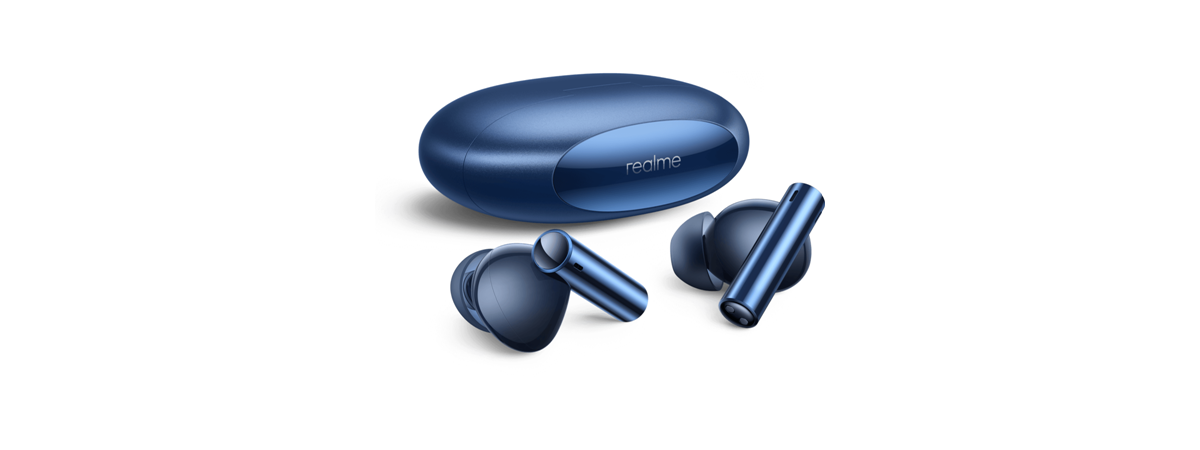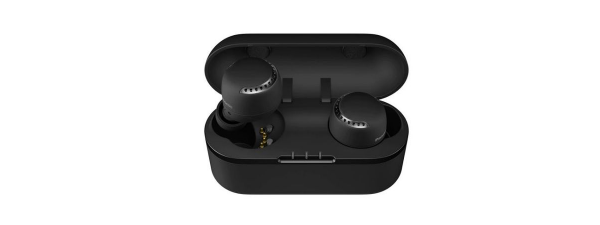
If you’re searching for a pair of budget wireless in-ear headphones, you can choose from quite a few brands and models - Jabra, Panasonic, Anker, Plantronics, Skullcandy, to name but a few. In this article, we are reviewing Sony’s proposition for the entry-level true wireless earbuds segment, the Sony WF-C500. They are small, reasonably priced, and have the Sony brand know-how and experience as a guarantee for their quality. Will they make it on your shortlist? Have they got enough bang for your buck? Read this review to find out how they perform:
Sony WF-C500: Who are they good for?
You should consider the Sony WF-C500 Truly Wireless Headphones if you:
- Listen to a lot of music on your mobile device(s)
- Dislike touch-sensitive earbuds
- Are away from a charger for long periods of time and don’t want to interrupt your listening to charge your headphones
- Enjoy jogging and need a pair of light, robust earbuds with decent sound quality
Pros and cons
There are several positives about the Sony WF-C500 Truly Wireless Headphones:
- They are sturdy and well-built
- They are comfortable
- The simple control scheme, coupled with the physical buttons, makes the device extremely easy to use
- The battery life for the earbuds is good
- Good-looking color selection
However, there are some things that aren’t to our liking:
- The microphones on the Sony WF-C500 have trouble picking up your voice in calls
- We had some connectivity issues on our test laptop when other Bluetooth devices were also connected
- The battery life of the charging case could have been better
Verdict
The Sony WF-C500 Truly Wireless Headphones are, first and foremost, a budget product. Thus, we cannot fault them for the lack of more advanced features like ANC. However, the quality of the integrated microphones is inadequate, and that makes them less desirable for phone calls. They are great for listening to music, both because of the long battery life and the fact that they’re comfortable to wear. The sound quality is correct for the price. We would recommend the Sony WF-C500 Truly Wireless Headphones to budget-conscious users who spend a lot of time listening to music on their iPhone or Android devices and don’t need them for frequent phone calls.
Unboxing of the Sony WF-C500 Truly Wireless Headphones
The Sony WF-C500 headphones come in a small white box, with high quality graphics and lots of information on it. The box is just 3.75 x 2.75 x 1.96 inches (95 x 70 x 50 mm) in size and, as expected, very light. On the front there’s a picture of the Coral Orange headphones, the model name and several technical specs.
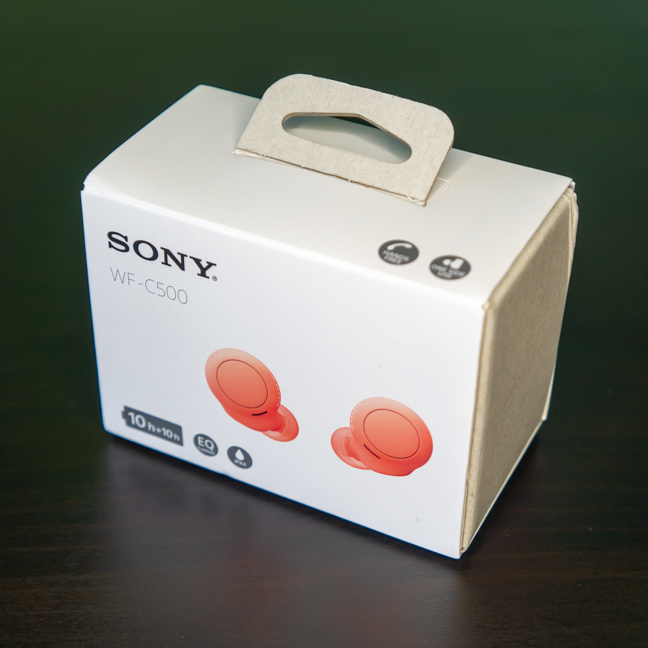
The front of the box that the Sony WF-C500 comes in
The back of the box contains other technical specs, as well as the product serial number. According to Sony, the packaging does not contain any plastic.
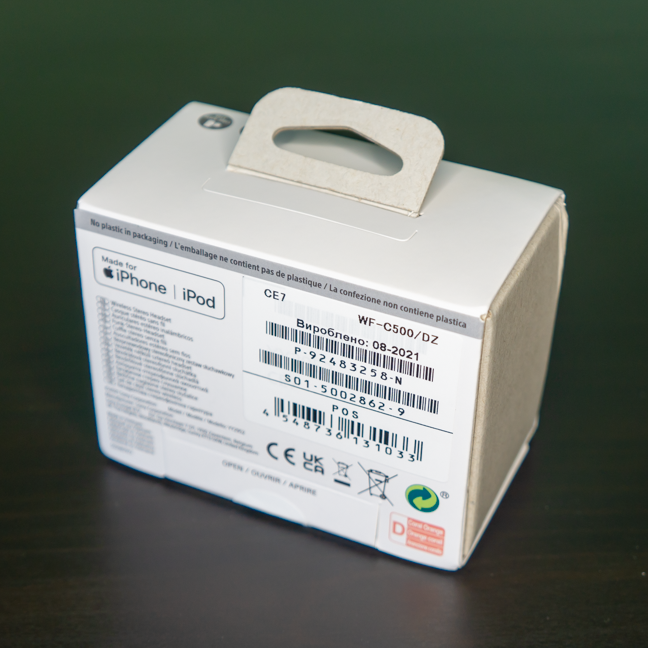
The back of the box has several technical specs and the serial number
The box contains the headphones, a charging case, two sets of bud tips, a USB-A to USB-C cable, plus the usual operating instructions in several languages.
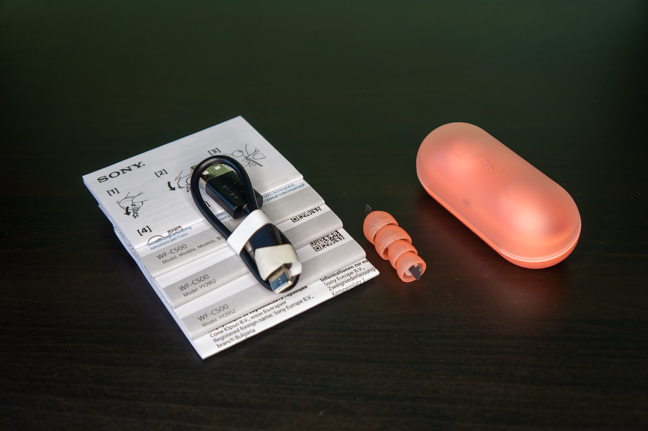
The contents are standard: charging case, ear tips, cable
Opening the charging case, we can take a first glance at the actual headphones. The semi-transparent lid of the case is easy to open and the case is very light.
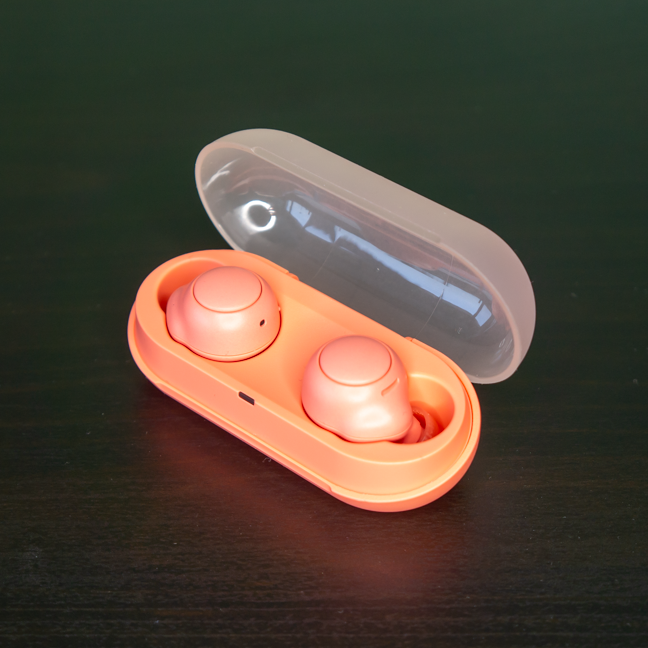
Simplicity usually means sturdiness, and the WF-C500 tick both boxes
The unboxing experience was pleasant. The included box is well-made and easy to open. We like that there is no plastic in the packaging, and the inner box is easily recyclable. The quality of the accessories is good, and they come well packaged separately from the case.
Design and hardware specifications
After opening the box, we first took a look at the accessories. The USB cable is very short (only 8.5 inches or 21.5 cm), but it should be enough for most use cases. The ear tips are the S and L sizes, with the M sized ones already mounted on the headphones.
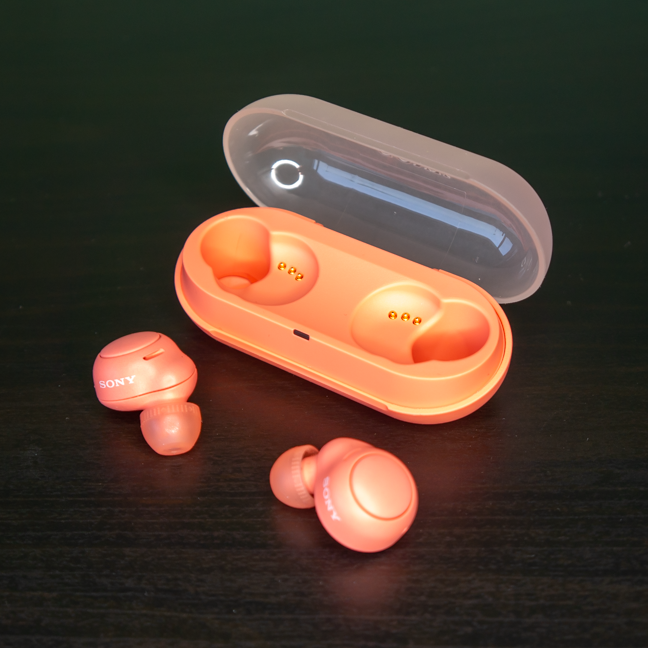
The charging case provides enough charge for 10 hours of playback
The charging case is sturdy and light, with a weight of just 1.23 oz (35 g). Its dimensions are 3.15 x 1.37 x 1.21 inches (80.0 x 34.9 x 30.9 mm). The lid is semitransparent and in dark environments, when the buds are charging, some of the amber light they emit can be seen through the lid. It also has a status LED that lights up when the case is charging. According to Sony, it has enough juice to fully charge the headphones once. Speaking of which, the battery life of the buds is really good: 10 hours of continuous playback plus another 10 provided by the case. The battery life is cut in half if you use the headphones for calls. The charge time for the case is roughly 3 hours, while the buds will charge to 100% in 2.5 hours, according to Sony. Furthermore, ten minutes of charging time will get you an hour of playback, which is nice if you are in a hurry and you forget to charge the earbuds beforehand.
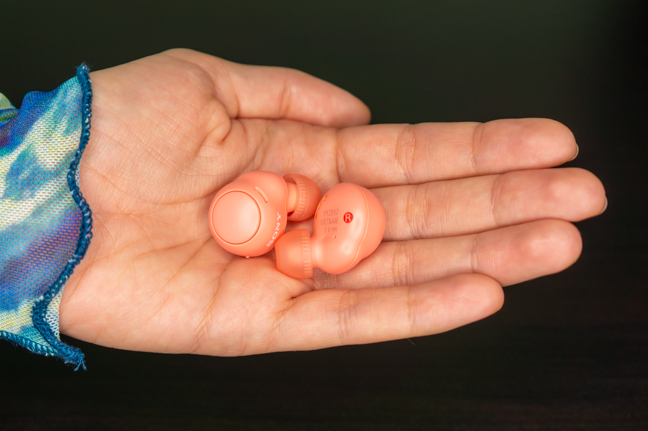
The Sony WF-C500 are small and light
The headphones are small, light (5.4 g each) and have 5.8mm driver units with a frequency response of 20Hz-20,000Hz (44.1kHz sampling). We reviewed the Coral Orange version, but the headphones are also available in lime green, black, and white.
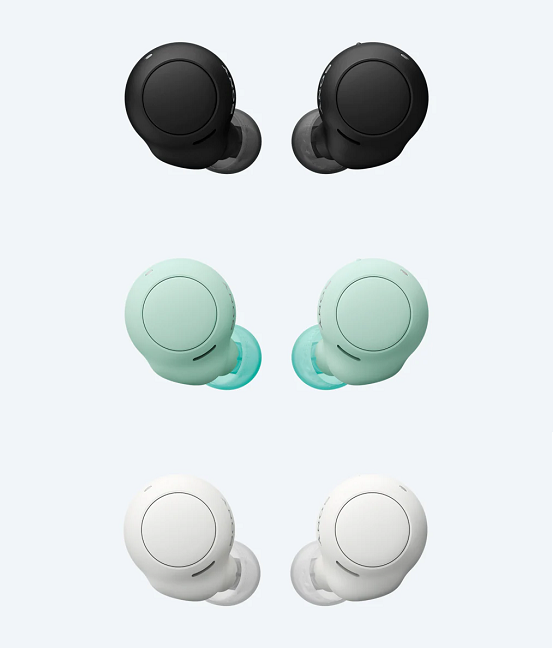
The Sony WF-C500 earbuds are also available in black, white, and lime green
Call us old-fashioned, but we love the fact that the Sony WF-C500 has physical controls. The buttons are relatively easy to press and provide sufficient feedback. The IPX4 certification means that the buds are safe from the occasional splash of water. The connection is made using Bluetooth 5.0.
You can find all the technical specs on this page: WF-C500 Truly Wireless Headphones.
Overall, the materials used are not cheap, and the semitransparent lid of the charging case is a nice design choice in our opinion. The buds and the case don’t feel premium, but rather sturdy and fit for daily use. There were no visible issues with the quality of the materials, and the technical specs are in line with the price.
Using the Sony WF-C500 Truly Wireless Headphones
Now, onwards to the fun stuff. The first thing that caught our eye was the fact that the headphones have physical controls. Why, in the age of capacitive buttons and touch screens, would you want actual buttons on your earbuds? There are two reasons for that:
- compared to the touch-sensitive earbuds, the probability of issuing a command accidentally is much, much lower;
- The haptic feedback from actually pressing a button on most touch-sensitive buds is zero. You only get beeps, which can be annoying to some users. With the Sony WF-C500, you can feel when you successfully press the button, so the usability is improved.
The physical buttons are coupled with a superb, if basic, control scheme: from the buttons you only get to control volume, the playing/pausing of media files, answering and ending calls, but when it comes to commands, simpler is sometimes better. For example, to increase the volume, you only need to press the left button once, and for decreasing it you simply keep the same button pressed until the volume drops to the desired level.

The controls are simplistic, but also simple
Having experienced complicated command schemes involving double or even triple taps on touch-sensitive buttons, this method is much more effective and precise.
The buds are small enough to fit most ears, and the included bud tips cover a wide range of ear canal sizes. We tried running while wearing them, and they didn’t fall off. A good thing, since they’re so small. Pro tip: if you choose the white or the orange ones, you will spot them easily if they do fall off 🙂
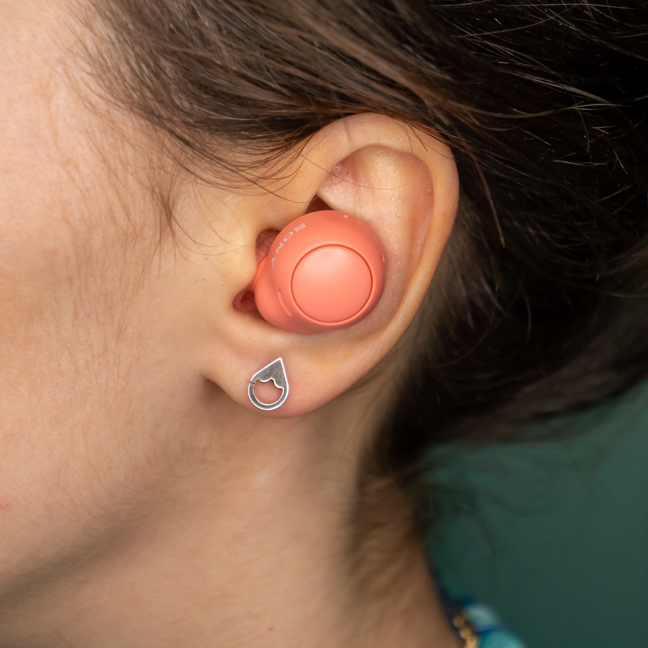
The physical buttons are large and provide good feedback
We first tested the buds by listening to music. The initial sound quality wasn’t amazing, the volume and the bass were good enough, but the mids and highs were, for lack of a better word, bland. The buds sounded average, but there was no real issue with quality. We then downloaded Headphones Connect, the Sony app dedicated to their whole range of wireless headphones, available both for Android and for iPhones. The app is packed with features and has a clean user interface. It even matches the color of the earbuds it connects to, because why not?
With the app, we were able to fine-tune the sound to our taste, as the app provides several presets and custom equalizer settings. It also has a section dedicated to providing the best sound, based on… pictures of your ears. Yes, you read that right. Apart from the fact that it works with only a few apps (like Tidal, for example), we’re not convinced that taking photos of our ears will help in achieving better sound. It’s like providing photos of your car to a tuning company so that they increase its performance solely based on those pictures. We believe that the competition’s approach, actually testing the hearing of the user on several frequencies, is more useful and yields better results. That being said, the selected apps that work with this feature did sound quite good.
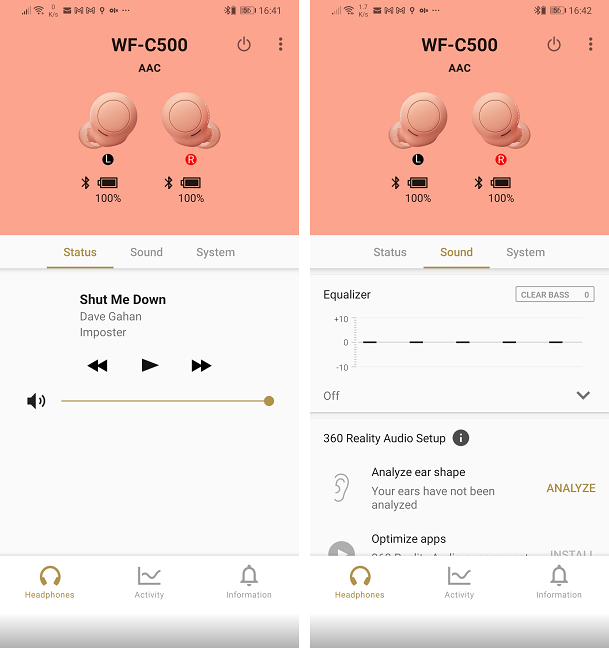
The Headphones Connect app is good-looking and useful
After tuning the sound using the app, the headphones sounded better, but still lacked the clarity of higher-end devices. We activated DSEE (Digital Sound Enhancement Engine), an algorithm developed by Sony to enhance the sound quality of the music, and the effect was subtle but clearly present. The end result was in line with the competition: good bass, clear highs, sufficiently-spaced instruments, overall a balanced and detailed sound.
We then tried them in their second most-used scenario: phone calls. Sadly, while the sound quality was good, the person on the other end of the call constantly had trouble hearing us. We tried it with several phones, but the result was the same. Moving on, you can’t really fault the Sony WF-C500 Truly Wireless Headphones for the lack of ANC (active noise cancellation), since it’s a budget headset. Furthermore, the noise suppression from having them in your ears is good enough. There is no ambient sound mode either (that’s when the earbuds play the surrounding sounds so that you can hear what’s happening around you even with the headphones on). If you prefer, though, you can use only one of the earbuds, a good choice if you’re driving, for example, and you still need to use the buds as a phone headset.
We moved on to connecting them to a laptop, to see if the issues were still present. Again, during video calls, the person on the other end would complain about the sound quality. Take a listen to a recording made in Windows 11 using the integrated Voice Recorder app:
Strangely, when connecting using a Bluetooth 4.0 dongle, we couldn’t even use the microphone on the Sony WF-C500, but it worked when connected via Bluetooth 5.0. Furthermore, we noticed an intermittent bug: at times, when the headphones were connected to our ASUS Zenbook Duo laptop, our Bluetooth mouse (also made by Asus) stopped working correctly. Your mileage may vary, depending on your devices, but our experience when using the Sony WF-C500 with a laptop wasn’t great.
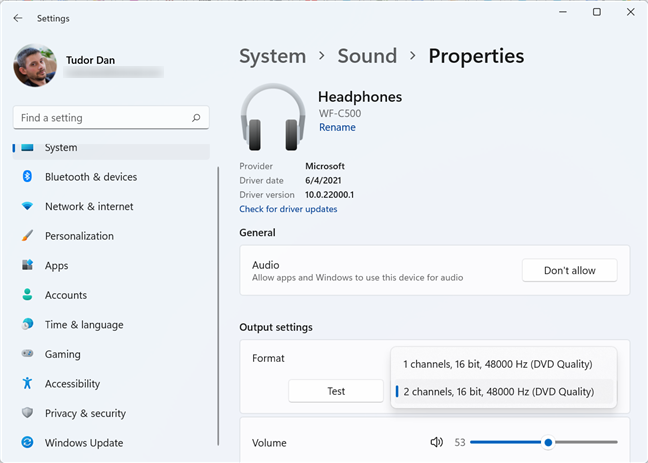
The Sony WF-C500 connected to a Windows 11 laptop
Finally, we tested the battery life, and here, the Sony WF-C500 Truly Wireless Headphones delivered in full: playing audio at moderate volume, we were able to surpass the battery run time specified by Sony. We got eleven hours, which, although not the best result out there, is certainly very good. If they aren’t used and not in their case, the Sony WF-C500 headphones turn off to save battery. To turn them back on, simply press the button on each earbud for a few seconds. If presented with the choice, we would have traded the very low weight of the case for a larger case battery capacity, able to fully charge the buds more than once. Still, 20 hours of combined playback time is not too shabby. Charging was quick - within three hours, the earbuds were ready to go.
Using the Sony WF-C500 Truly Wireless Headphones is a mixed experience: the headphones are perfect for daily use together with a smartphone, but only for music playback. For calls, the sound picked up by the integrated microphones is not great, and when connecting to computers, you can encounter connection issues while also using other Bluetooth devices. The control scheme is very good, and you can easily listen to your favorite music on these earbuds for a full day thanks to the good battery life.
What's your opinion about the Sony WF-C500 Truly Wireless Headphones?
The search for wireless earbuds is long and tedious. You are bombarded with technical specs and feature lists, but more than other wearables, choosing the right earbuds depends a lot on your anatomy and personal preferences. We hope we were able to shed some light on what it’s like to use the Sony WF-C500 Truly Wireless Headphones. Before you leave, we’d like to know your opinion on these budget wireless earbuds. If you own a pair, it would be great if you could also describe in the comment section your experience with them, so that other users can get a clearer picture.


 29.11.2021
29.11.2021 